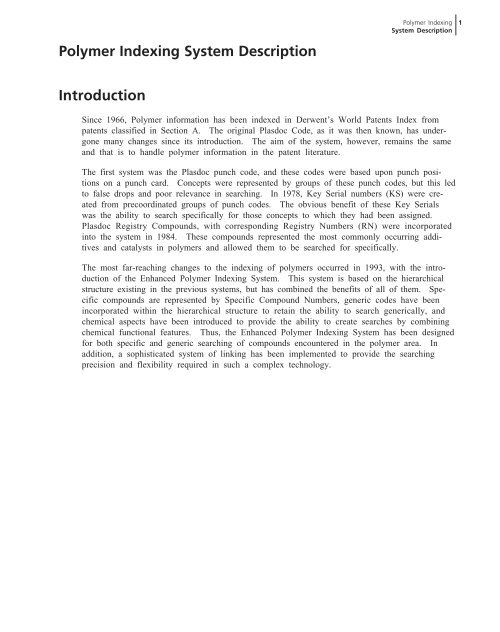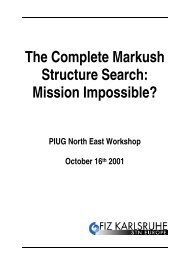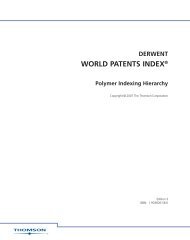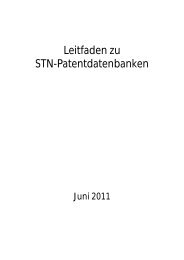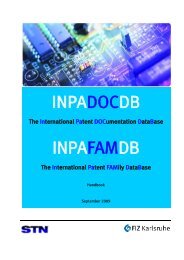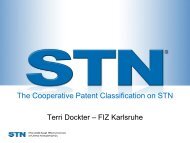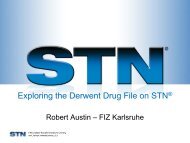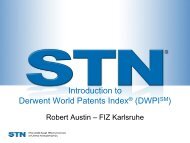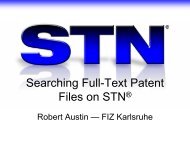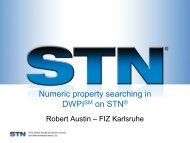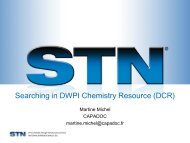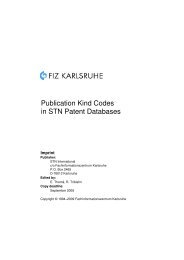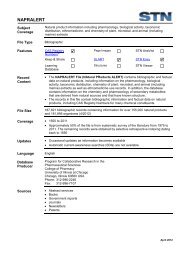- Page 1 and 2: DERWENT WORLD PATENTS INDEX ® Poly
- Page 3: Polymer Indexing System Description
- Page 9 and 10: Polymer Indexing System Description
- Page 11 and 12: Polymer Indexing System Description
- Page 13 and 14: Polymer Indexing System Description
- Page 15 and 16: Polymer Indexing System Description
- Page 17 and 18: Concepts which can only be retrieve
- Page 19 and 20: Polymer Indexing System Description
- Page 21: Polymer Indexing System Description
- Page 24 and 25: 20 lubricants they too would be lin
- Page 26 and 27: 22 Example 2 Aqueous dispersion obt
- Page 28 and 29: 24 Example 4 Multi-ply film for pac
- Page 30 and 31: 26 Example 6 Hot melt adhesive cont
- Page 32 and 33: 28 Example 8 Paint composition for
- Page 34 and 35: 30 Polymer Indexing Hierarchy The H
- Page 36 and 37: 32 II The Polymer Indexing Molecula
- Page 38 and 39: 34 Specific compounds with SCN We w
- Page 40 and 41: 36 D82 2 Carbons Cl Chlorine Apart
- Page 42 and 43: 38 Polyurethane from a diisocyanate
- Page 44 and 45: 40 Compound(s) with more than one f
- Page 46 and 47: 42 H0226 is Modifying agent, H0000
- Page 48 and 49: 44 The search would be: R00351 (2)
- Page 50 and 51: 46 Dimethylaminoethyl methacrylate
- Page 52 and 53: 48 Polyamide fabric from a terephth
- Page 54 and 55:
50 Polyesteramide ordered cocondens
- Page 56 and 57:
52 Blend of propylene homopolymer w
- Page 58 and 59:
54 Polyurethane foam from Toluene d
- Page 60 and 61:
56 Multilayer packaging film from e
- Page 63 and 64:
Polymer Indexing System Description
- Page 65 and 66:
Polymer Indexing System Description
- Page 67 and 68:
Polymer Indexing System Description
- Page 69 and 70:
Polymer Indexing System Description
- Page 71 and 72:
Polymer Indexing System Description
- Page 73 and 74:
Polymer Indexing System Description
- Page 75:
Polymer Indexing System Description
- Page 78 and 79:
74 Q QUESTEL 49 Questel English 33
- Page 80 and 81:
Copyright © 2007 The Thomson Corpr
- Page 83:
Polymer Indexing Hierarchy Introduc
- Page 87 and 88:
Polymer Indexing Hierarchy Polymer
- Page 89 and 90:
Polymer Indexing Hierarchy Polymer
- Page 91 and 92:
Polymer Indexing Hierarchy Polymer
- Page 93 and 94:
R24091 NT Lauryl acrylate (04) R240
- Page 95 and 96:
Polymer Indexing Hierarchy Polymer
- Page 97 and 98:
Polymer Indexing Hierarchy Polymer
- Page 99 and 100:
Polymer Indexing Hierarchy Polymer
- Page 101 and 102:
Polymer Indexing Hierarchy Polymer
- Page 103 and 104:
Polymer Indexing Hierarchy Polymer
- Page 105 and 106:
Polymer Indexing Hierarchy Polymer
- Page 107:
Polymer Indexing Hierarchy Polymer
- Page 110 and 111:
28 P0340 NT Polychloroprene UF Neop
- Page 112 and 113:
30 P0840 NT Alkyd resin “Includes
- Page 114 and 115:
32 P0180 NT Ethylene - Ethyl acryla
- Page 116 and 117:
34 P1321 NT Ethylene - Vinyl acetat
- Page 119:
Polymer Indexing Hierarchy Natural
- Page 122 and 123:
40 G3678 NT Cellulose ethers R01835
- Page 125 and 126:
Polymer Indexing Hierarchy Modified
- Page 127:
Polymer Indexing Hierarchy Modified
- Page 131 and 132:
Polymer Indexing Hierarchy Chemical
- Page 133 and 134:
Polymer Indexing Hierarchy Chemical
- Page 135 and 136:
Polymer Indexing Hierarchy Chemical
- Page 137 and 138:
Polymer Indexing Hierarchy Chemical
- Page 139 and 140:
Polymer Indexing Hierarchy Chemical
- Page 141 and 142:
Polymer Indexing Hierarchy Chemical
- Page 143 and 144:
Polymer Indexing Hierarchy Chemical
- Page 145 and 146:
Polymer Indexing Hierarchy Chemical
- Page 147 and 148:
Polymer Indexing Hierarchy Chemical
- Page 149 and 150:
Polymer Indexing Hierarchy Chemical
- Page 151 and 152:
Polymer Indexing Hierarchy Chemical
- Page 153 and 154:
R05344 R04510 R04571 G3236 R05346 R
- Page 155 and 156:
Polymer Indexing Hierarchy Chemical
- Page 157:
Polymer Indexing Hierarchy Chemical
- Page 160 and 161:
78 Indexing Conventions: Chemical A
- Page 162 and 163:
80 Number of rings: “Applied for
- Page 164 and 165:
82 D92 Carbon count 12 C D93 Carbon
- Page 166 and 167:
84 F26 Alcohol “Excluding phenoli
- Page 168 and 169:
86 Si: F80 Silicate F81 Si-O-Si F82
- Page 170 and 171:
88 7B Group 7B “Mn, Tc, Re” Mn
- Page 173:
Polymer Indexing Hierarchy Novelty
- Page 177:
Polymer Indexing Hierarchy Universa
- Page 180 and 181:
98 K9552 NT Metal interface “Incl
- Page 182 and 183:
100
- Page 184 and 185:
102
- Page 186 and 187:
104 UF Poly-lobal fibre S1230 NT Fi
- Page 188 and 189:
106
- Page 190 and 191:
108
- Page 192 and 193:
110 A157 Crosslinking agent UF Cros
- Page 194 and 195:
112 A566 Surfactant A577 NT Antiblo
- Page 196 and 197:
114
- Page 198 and 199:
116 C248 C259 C260 C271 C282 C293 C
- Page 200 and 201:
118
- Page 202 and 203:
120 L2277 Halosulphonation UF Halos
- Page 204 and 205:
122 L2799 L2802 L2813 L2824 L2835 C
- Page 206 and 207:
124
- Page 208 and 209:
126 N5936 NT Uniaxially orienting S
- Page 210 and 211:
128 N7307 NT Stereographic moulding
- Page 212 and 213:
130 N7158 NT Coating with polymer f
- Page 214 and 215:
132
- Page 216 and 217:
134
- Page 218 and 219:
136
- Page 220 and 221:
138 B3292 NT Electrostatics B3305 N
- Page 222 and 223:
140 B3792 NT Hardness UF Barcol har
- Page 224 and 225:
142 B4331 NT Optically anisotropic
- Page 226 and 227:
144 B4831 NT Density B4842 NT Bulk
- Page 228 and 229:
146 B5538 NT Thermal expansion B554
- Page 230 and 231:
148
- Page 232 and 233:
150 Q6780 Barrier layers “Where s
- Page 234 and 235:
152 Q7250 Q7261 Q7272 Q7283 UF UF S
- Page 236 and 237:
154 Q7658 Glazing “Polymer used i
- Page 238 and 239:
156 Q7987 Medical use UF Surgical u
- Page 240 and 241:
158 Q8571 NT Packaging, other SA La
- Page 242 and 243:
160 Q9041 Spectacle frames SA Spect
- Page 244 and 245:
162
- Page 246 and 247:
Copyright © 2007 The Thomson Corpo
- Page 249:
POLYMER INDEXING CODE LIST
- Page 253 and 254:
00 Code Group List 00 00-R 1A 1B 2A
- Page 255 and 256:
A704 A715 A726 A737 A748 A759 Gelli
- Page 257 and 258:
B3678 Solution viscosity B9999 B367
- Page 259 and 260:
Polymer Indexing Reference Manual C
- Page 261 and 262:
Polymer Indexing Reference Manual C
- Page 263 and 264:
D04 D05 D06 D07 D08 D09 D10 D11 D12
- Page 265 and 266:
D92 Carbon count 12 C D92 D93 Carbo
- Page 267 and 268:
Polymer Indexing Reference Manual C
- Page 269 and 270:
G0146 Bromomethyl styrene G0146 G01
- Page 271 and 272:
Polymer Indexing Reference Manual C
- Page 273 and 274:
G1478 G1489 G1490 G1503 G1514 G1525
- Page 275 and 276:
Polymer Indexing Reference Manual C
- Page 277 and 278:
Polymer Indexing Reference Manual C
- Page 279 and 280:
G4080 Adamantyl acrylates, other (0
- Page 281 and 282:
J6611 Equipment control devices (04
- Page 283 and 284:
Polymer Indexing Reference Manual C
- Page 285 and 286:
Polymer Indexing Reference Manual C
- Page 287 and 288:
Polymer Indexing Reference Manual C
- Page 289 and 290:
N6962 N6973 N6984 N6995 N7001 N7012
- Page 291 and 292:
P0282 P0293 P0306 P0317 P0328 P0339
- Page 293 and 294:
P1069 P1070 P1081 P1092 P1105 P1116
- Page 295 and 296:
Polymer Indexing Reference Manual C
- Page 297 and 298:
Polymer Indexing Reference Manual C
- Page 299 and 300:
Polymer Indexing Reference Manual C
- Page 301 and 302:
Polymer Indexing Reference Manual C
- Page 303 and 304:
Polymer Indexing Reference Manual C
- Page 305 and 306:
R00428 Isopentane (96) R00428 D01 D
- Page 307 and 308:
Polymer Indexing Reference Manual C
- Page 309 and 310:
Polymer Indexing Reference Manual C
- Page 311 and 312:
R00956 R00964 R00966 R00967 R00968
- Page 313 and 314:
Polymer Indexing Reference Manual C
- Page 315 and 316:
R01463 Hydroxyethyl methacrylate, 2
- Page 317 and 318:
Polymer Indexing Reference Manual C
- Page 319 and 320:
Polymer Indexing Reference Manual C
- Page 321 and 322:
Polymer Indexing Reference Manual C
- Page 323 and 324:
R05143 R05144 Dihexyl adipate R0514
- Page 325 and 326:
Polymer Indexing Reference Manual C
- Page 327 and 328:
R05338 R05339 R05340 R05342 R05343
- Page 329 and 330:
Polymer Indexing Reference Manual C
- Page 331 and 332:
Polymer Indexing Reference Manual C
- Page 333 and 334:
Polymer Indexing Reference Manual C
- Page 335 and 336:
Polymer Indexing Reference Manual C
- Page 337 and 338:
Polymer Indexing Reference Manual C
- Page 339:
Polymer Indexing Reference Manual C
- Page 343:
Polymer Indexing Reference Manual M
- Page 346 and 347:
94 BaH 2 O 2 R02001 Barium hydroxid
- Page 348 and 349:
96 CO 2 R01066 Carbon dioxide CO 3
- Page 350 and 351:
98 C 2 H 5 AlCl 2 R01381 Ethyl alum
- Page 352 and 353:
100 C 3 H 7 N R00815 Allyl amine C
- Page 354 and 355:
102 C 4 H 6 O 3 R00840 Acetic anhyd
- Page 356 and 357:
104 C 4 H 10 O 2 R00908 Butane diol
- Page 358 and 359:
106 C 5 H 10 NNaS 2 R05322 Sodium d
- Page 360 and 361:
108 C 6 H 8 O 2 R01479 Allyl acryla
- Page 362 and 363:
110 C 6 H 14 O 2 R00939 Butyl cello
- Page 364 and 365:
112 C 7 H 9 NO 3 R24054 1-Isocyanat
- Page 366 and 367:
114 C 8 H 8 O R00638 Styrene oxide
- Page 368 and 369:
116 C 8 H 18 S R05289 Octyl mercapt
- Page 370 and 371:
118 C 9 H 15 Br 6 O 4 P R05372 Tri(
- Page 372 and 373:
120 C 10 H 16 N 2 O 8 R00195 Ethyle
- Page 374 and 375:
122 C 12 H 11 NOS R05253 Thioglycol
- Page 376 and 377:
124 C 12 H 27 P R05369 Tributyl pho
- Page 378 and 379:
126 C 14 H 26 O 4 R05115 Dibutyl ad
- Page 380 and 381:
128 C 17 H 20 O 8 R17444 Pentaeryth
- Page 382 and 383:
130 C 20 H 22 O 5 R05176 Dipropylen
- Page 384 and 385:
132 C 24 H 38 O 4 R00981 Diisooctyl
- Page 386 and 387:
134 C 36 H 75 O 3 P R05377 Tridodec
- Page 388 and 389:
136 Cl 3 Cr R01883 Chromium(III) ch
- Page 390 and 391:
138 H 8 N 2 O 8 S 2 R03252 Ammonium
- Page 392 and 393:
140
- Page 395 and 396:
Polymer Indexing Reference Manual C
- Page 397 and 398:
Polymer Indexing Reference Manual C
- Page 399 and 400:
Polymer Indexing Reference Manual C
- Page 401 and 402:
Polymer Indexing Reference Manual C
- Page 403 and 404:
Polymer Indexing Reference Manual C
- Page 405 and 406:
Polymer Indexing Reference Manual C
- Page 407 and 408:
Polymer Indexing Reference Manual C
- Page 409 and 410:
Polymer Indexing Reference Manual C
- Page 411 and 412:
Polymer Indexing Reference Manual C
- Page 413 and 414:
DERWENT WORLD PATENTS INDEX ® Poly
- Page 415:
Polymer Indexing Thesaurus Contents
- Page 418 and 419:
2 NT and BT are converses and so ar
- Page 420 and 421:
4 B3383 Absorption [properties] NT
- Page 422 and 423:
6 B4751 Acid number [properties]
- Page 424 and 425:
8 G0293 Acrylic acid salt, other [p
- Page 426 and 427:
10 R00817 Acrylonitrile [polymer fo
- Page 428 and 429:
12 B5301 Adhesiveness [properties]
- Page 430 and 431:
14 G0997 Alcohols [polymer formers]
- Page 432 and 433:
16 P0840 Alkyd resin [polymer types
- Page 434 and 435:
18 R02020 Aluminium hydroxide [chem
- Page 436 and 437:
20 R01425 Ammonium acetate [chemica
- Page 438 and 439:
22 G2482 Antimony oxides (gen) [che
- Page 440 and 441:
24 At Astatine [chemical aspects] B
- Page 442 and 443:
26 {Barium sulfate} [chemicals] USE
- Page 444 and 445:
28 R15286 Benzoguanamine [polymer f
- Page 446 and 447:
30 C044 Biological catalyst [cataly
- Page 448 and 449:
32 {Bis(4-hydroxyphenyl)propane, 2,
- Page 450 and 451:
34 G1230 Bisphenol sulphones [polym
- Page 452 and 453:
36 B- Boron [chemical aspects] BT G
- Page 454 and 455:
38 {Bulked fibre} [shape & form] US
- Page 456 and 457:
40 G0055 Butenes (gen) [polymer for
- Page 458 and 459:
42 G2608 Butyl lithium (gen) [chemi
- Page 460 and 461:
44 Cd Cadmium [chemical aspects] BT
- Page 462 and 463:
46 G1296 Carbonates [polymer former
- Page 464 and 465:
48 {Carboxylic acid salt} [chemical
- Page 466 and 467:
50 C328 Catalyst for polymerisation
- Page 468 and 469:
52 G3645 Cellulose esters [natural
- Page 470 and 471:
54 {Chain flexibility} [properties]
- Page 472 and 473:
56 G0135 Chloromethyl styrene [poly
- Page 474 and 475:
58 N6688 Cleaning [physical operati
- Page 476 and 477:
60 N7078 Coating by spreading [phys
- Page 478 and 479:
62 {Coloring agent} [additives] USE
- Page 480 and 481:
64 {Condensant} [polymer descriptor
- Page 482 and 483:
66 G2711 Copper acetates (gen) [che
- Page 484 and 485:
68 R00846 Cresol, 3- [polymer forme
- Page 486 and 487:
70 Cm Curium [chemical aspects] BT
- Page 488 and 489:
72 R05104 Cyclohexylthiophthalimide
- Page 490 and 491:
74 M2095 Degraded polymer [modified
- Page 492 and 493:
76 R03275 Dextrin [natural polymers
- Page 494 and 495:
78 R00905 Diaminobutane, 1,4- [poly
- Page 496 and 497:
80 R00632 Diamino toluene, 2,4- [po
- Page 498 and 499:
82 R04425 Dibenzylidene sorbitol [c
- Page 500 and 501:
84 R00811 Dichloroethane, 1,2- [che
- Page 502 and 503:
86 R01595 Diethylene glycol dimetha
- Page 504 and 505:
88 R24064 Diisobutyl aluminium chlo
- Page 506 and 507:
90 R01020 Dimethyl aniline, N,N- [p
- Page 508 and 509:
92 R05169 Dioctyl sulphosuccinic ac
- Page 510 and 511:
94 G1887 Diphenylmethane diisocyana
- Page 512 and 513:
96 R05181 Ditridecyl phthalate [che
- Page 514 and 515:
98 Q8106 Drilling fluid [applicatio
- Page 516 and 517:
100 B3894 Elastic memory [propertie
- Page 518 and 519:
102 Q9472 Electroluminescent device
- Page 520 and 521:
104 H0362 End functional polymer (2
- Page 522 and 523:
106 G2222 Epoxidised vegetable oil
- Page 524 and 525:
108 B5469 Etched [properties] BT Su
- Page 526 and 527:
110 R00822 Ethylene glycol [polymer
- Page 528 and 529:
112 G2857 Ethyl magnesium halide [c
- Page 530 and 531:
114 B3918 Fatigue [properties] BT S
- Page 532 and 533:
116 N6984 Flash spinning [physical
- Page 534 and 535:
118 {Folding endurance} [properties
- Page 536 and 537:
120 P0577 Furan resin [polymer type
- Page 538 and 539:
122 {Glycerine} [polymer formers] U
- Page 540 and 541:
124 S1376 Grease [shape & form] UF
- Page 542 and 543:
126 6B Group 6B [chemical aspects]
- Page 544 and 545:
128 G0431 Alpha-Haloacrylic acid es
- Page 546 and 547:
130 B5594 Heat distortion point [pr
- Page 548 and 549:
132 R00515 Hexahydrophthalic anhydr
- Page 550 and 551:
134 K9450 High pressure [universal
- Page 552 and 553:
136 L2299 Hydrocarbylation [chemica
- Page 554 and 555:
138 G0408 Hydroxyalkyl methacrylate
- Page 556 and 557:
140 R06653 Hydroxystearic acid, 12-
- Page 558 and 559:
142 G2335 Inorganic polymer formers
- Page 560 and 561:
144 I- Iodine [chemical aspects] BT
- Page 562 and 563:
146 R24029 Isobutyl acrylate [polym
- Page 564 and 565:
148 R00429 Isoprene [polymer former
- Page 566 and 567:
150 {Kevlar} USE [polymer types] Po
- Page 568 and 569:
152 R01147 Lauric acid [chemicals]
- Page 570 and 571:
154 B3098 Light degradability [prop
- Page 572 and 573:
156 A339 Low profile additive [addi
- Page 574 and 575:
158 Q8899 Magnetic recording tapes
- Page 576 and 577:
160 Q7885 Mechanical engineering [a
- Page 578 and 579:
162 B3612 Melt viscosity [propertie
- Page 580 and 581:
164 R00459 Methacrylamide [polymer
- Page 582 and 583:
166 R24009 Methallyl sulphonic acid
- Page 584 and 585:
168 R05362 Methylhydroquinone [poly
- Page 586 and 587:
170 S1401 Microcapsule [shape & for
- Page 588 and 589:
172 {Molecular weight control agent
- Page 590 and 591:
174 G0022 Monoolefinic [polymer for
- Page 592 and 593:
176 K9676 Multilayer structure [uni
- Page 594 and 595:
178 {Necking} USE [properties] Draw
- Page 596 and 597:
180 {Non-drying oil} [polymer forme
- Page 598 and 599:
182 P8128 Nylon 6/66/6I (2004) [pol
- Page 600 and 601:
184 {Oiling agent for fibres and te
- Page 602 and 603:
186 {Optical storage} [applications
- Page 604 and 605:
188 {Oxydianiline, 3,4'-} [polymer
- Page 606 and 607:
190 S1456 Particulate form [shape &
- Page 608 and 609:
192 {Percentage modulus} [propertie
- Page 610 and 611:
194 R00850 Phenylene diamine, 3- [c
- Page 612 and 613:
196 {Photostabiliser} [additives] U
- Page 614 and 615:
198 Q8719 Pipework [applications] N
- Page 616 and 617:
200 G2357 Polyallyl sucrose [polyme
- Page 618 and 619:
202 Oleic acid - {Ordered cocondens
- Page 620 and 621:
204 P1058 Polyetherurethane [polyme
- Page 622 and 623:
206 K9745 Polymer blend [universal
- Page 624 and 625:
208 {Polymerization} [chemical proc
- Page 626 and 627:
210 R13366 Polyoxyethylene sorbitan
- Page 628 and 629:
212 {Polysulfonamide} [polymer type
- Page 630 and 631:
214 P1809 Polyvinyl chloride [polym
- Page 632 and 633:
216 B5481 Printed [properties] BT S
- Page 634 and 635:
218 P1354 Propylene - Vinyl chlorid
- Page 636 and 637:
220 {Pyrolysis} USE [chemical proce
- Page 638 and 639:
222 N6508 Reaction injection mouldi
- Page 640 and 641:
224 L2631 Residual polymer former p
- Page 642 and 643:
226 D42 Ring contg 1 O [chemical as
- Page 644 and 645:
228 {Sand} USE [chemicals] Quartz G
- Page 646 and 647:
230 B5674 Second order nonlinearity
- Page 648 and 649:
232 {Shrink reducing agent} [additi
- Page 650 and 651:
234 F88 Si-Si (96) [chemical aspect
- Page 652 and 653:
236 {Sodium dodecyl sulfate} [chemi
- Page 654 and 655:
238 {Solar cells} [applications] US
- Page 656 and 657:
240 B3316 Spark hazards [properties
- Page 658 and 659:
242 B4739 Stability to other agents
- Page 660 and 661:
244 B3861 Stress cracking [properti
- Page 662 and 663:
246 P0395 Styrene - Isoprene BCP [p
- Page 664 and 665:
248 {Sulfonic acids + salts} [polym
- Page 666 and 667:
250 B5378 Surface irregularities [p
- Page 668 and 669:
252 N5903 Syrup forming [physical o
- Page 670 and 671:
254 B4080 Tensile modulus [properti
- Page 672 and 673:
256 R00895 Tetrahydrofuran [polymer
- Page 674 and 675:
258 B5505 Thermal properties [prope
- Page 676 and 677:
260 A726 Thixotrope [additives] BT
- Page 678 and 679:
262 Q9187 Toilet requisites for hai
- Page 680 and 681:
264 B3258 Tracking [properties] BT
- Page 682 and 683:
266 R00375 Trichloromonofluorometha
- Page 684 and 685:
268 R05384 Triisooctyl trimellitate
- Page 686 and 687:
270 F59 Tri or higher isocyanate (2
- Page 688 and 689:
272 {Ultrafiltration membrane} USE
- Page 690 and 691:
274 {Urotropin} USE Hexamethylene t
- Page 692 and 693:
276 G4148 Vinyl amides, N- (2004) [
- Page 694 and 695:
278 R01405 Vinylidene bromide [poly
- Page 696 and 697:
280 R00725 Vinyl toluene, 3- [polym
- Page 698 and 699:
282 Q6893 Walls and coverings [appl
- Page 700 and 701:
284 N6031 Weaving [physical operati
- Page 702 and 703:
286 G1127 Xylenols (gen) [polymer f
- Page 704:
288


